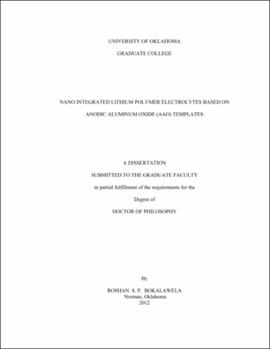| dc.contributor.advisor | Johnson, Matthew B | |
| dc.creator | Bokalawela, Roshan S. P. | |
| dc.date.accessioned | 2019-04-27T21:33:49Z | |
| dc.date.available | 2019-04-27T21:33:49Z | |
| dc.date.issued | 2012 | |
| dc.identifier | 99304564202042 | |
| dc.identifier.uri | https://hdl.handle.net/11244/319028 | |
| dc.description.abstract | Since their discovery in the 1970s, polymer electrolytes have been actively studied because they have properties important for many device applications. However, even after 40 years, the detailed mechanisms of conductivity in these electrolytes are still not completely understood. Moreover, the conductivity in polymer electrolytes is one of the limiting factors of these devices so that different methods to enhance conductivity are actively being explored. One proposed method of enhancing the conductivity is to confine the polymer electrolyte in the nanoscale, but the study of material properties at the nanoscale is challenging in this area. In this work, we confine poly(ethylene oxide) lithium triflate (PEO:LiTf)(X:1)X=10,30 polymer electrolytes in carefully fabricated nanometer-diameter anodized aluminum oxide (AAO) pore structures. We demonstrate two orders of magnitude higher conductivity in the confined structures versus that of bulk films. Using x-ray characterization we show that this increased conductivity is associated with ordered PEO polymer chains aligned in the template pore direction. The activation energy of the AAO-confined polymer electrolyte is found to be smaller than that of the unconfined melt and about half that of the unconfined solid. This result indicates that not only is the room-temperature confined polymer ordered, but that this order persists at temperatures where the nano-confined polymer electrolyte is expected to be a liquid. | |
| dc.description.abstract | The geometric bulk resistances of the electrolytes were obtained by AC-impedance spectra, from which the ionic conductivities were calculated. The Arrhenius plots of temperature dependent ionic conductivities showed that the usual melting temperature of the PEO phase in confined PEO:LiTf(X:1) X=10,30 is suppressed and a single activation energy was evident throughout the temperature range 25-90 °C. | |
| dc.description.abstract | Wide-angle x-ray scattering (WAXS) patterns show that the polymer chains in both the pure PEO and PEO:LiTf(10:1) electrolyte are aligned along the pore axis and that the structure is ordered in the nano pores. This was based on our observations that the intensity of the PEO crystalline peaks at 19.2° (120) and 23.0° [(hk2) and (hk4)] when the incident x-ray beam was parallel to the pore axes was reduced, but intensity of recovered when the pores were tilted by 10° with respect to the incident x-ray beam. | |
| dc.description.abstract | Exploring the infra-redred and Raman vibrational spectra of nano-confined pure PEO and PEO:LiTf(10:1) structures with the bulk films, we found that the IR absorbance bands and the Raman intensities showed a high dichroism to the normal and parallel electric fields of the IR radiation. The parallel band intensity decreased while the normal band intensity increased, consistent with an alignment of the polymer chains along the pore direction. | |
| dc.description.abstract | To perform this research, on our millimeter-sized, hygroscopic samples, substantial changes in the implementation of the characterization techniques such as: AC-impedance spectroscopy, FTIR, Raman-scattering, WAXS, and SEM were required. These changes included: new sample holders to prevent water uptake; a new method to align samples to ensure consistent and reproducible measurements with the new holder designs; and the development and implementation of an entirely new system for measuring the conductivity versus temperature of our template samples in a glovebox. | |
| dc.description.abstract | The Appendices at the end of this thesis include details of the developed procedures and apparatus, as well as additional experimental results not shown in the thesis. | |
| dc.format.extent | 176 pages | |
| dc.format.medium | application.pdf | |
| dc.language | en_US | |
| dc.relation.requires | Adobe Acrobat Reader | |
| dc.subject | Polyelectrolytes | |
| dc.subject | Aluminum oxide | |
| dc.subject | Metals--Anodic oxidization | |
| dc.subject | Lithium | |
| dc.subject | Electrolytes--Conductivity | |
| dc.title | NANO INTEGRATED LITHIUM POLYMER ELECTROLYTES BASED ON ANODIC ALUMINUM OXIDE (AAO) TEMPLATES | |
| dc.type | text | |
| dc.type | document | |
| dc.thesis.degree | Ph.D. | |
| ou.group | College of Arts and Sciences::Homer L. Dodge Department of Physics and Astronomy | |
